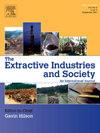ESG ratings in the mining industry: Factors and implications
IF 3.6
2区 社会学
Q2 ENVIRONMENTAL STUDIES
Extractive Industries and Society-An International Journal
Pub Date : 2024-10-03
DOI:10.1016/j.exis.2024.101521
引用次数: 0
Abstract
While previous research explores the relationship between ESG ratings, firm size, and financial outcomes, there is a lack of comprehensive analysis comparing multiple ESG ratings within the mining industry. This gap is crucial given the increasing focus on ESG in mining operations and its potential impact on company performance. Based on proprietary financial and ESG ratings data from 200 mining companies, this study investigates the relationship between two different ESG ratings and firm characteristics. We compare ESG-rated firms with unrated firms in terms of firm size, and financial performance indicators, and explore country-level patterns in ESG ratings. Findings reveal that ESG-rated mining companies are generally larger than unrated firms but neither more profitable nor face lower debt costs. The results also show that, among rated firms, larger mining firms have more favorable ESG ratings than smaller ones. However, we fail to find a correlation between ESG ratings and financial performance. Finally, the evidence suggests that mining companies rated high for unmanaged ESG risk are likely to have lower ESG scores. This research contributes to understanding whether and how ESG ratings could impact investment decisions and risk management strategies in the mining sector.
采矿业的环境、社会和公司治理评级:因素和影响
以往的研究探讨了环境、社会和公司治理评级、公司规模和财务结果之间的关系,但缺乏对采矿业内多种环境、社会和公司治理评级进行比较的全面分析。鉴于人们越来越关注矿业运营中的环境、社会和公司治理及其对公司业绩的潜在影响,这一差距至关重要。基于 200 家矿业公司的专有财务和 ESG 评级数据,本研究调查了两种不同 ESG 评级与公司特征之间的关系。我们比较了获得 ESG 评级的公司和未获得 ESG 评级的公司在公司规模和财务业绩指标方面的情况,并探讨了 ESG 评级在国家层面的模式。研究结果表明,获得 ESG 评级的矿业公司一般比未获得评级的公司规模更大,但利润率和债务成本都不高。结果还显示,在获得评级的公司中,规模较大的矿业公司比规模较小的公司获得更有利的 ESG 评级。但是,我们没有发现环境、社会和公司治理评级与财务业绩之间的相关性。最后,有证据表明,因未管理环境、社会和公司治理风险而被评为高评级的矿业公司,其环境、社会和公司治理得分可能较低。这项研究有助于了解环境、社会和公司治理评级是否以及如何影响采矿业的投资决策和风险管理策略。
本文章由计算机程序翻译,如有差异,请以英文原文为准。
求助全文
约1分钟内获得全文
求助全文
来源期刊

Extractive Industries and Society-An International Journal
ENVIRONMENTAL STUDIES-
CiteScore
6.60
自引率
19.40%
发文量
135
 求助内容:
求助内容: 应助结果提醒方式:
应助结果提醒方式:


